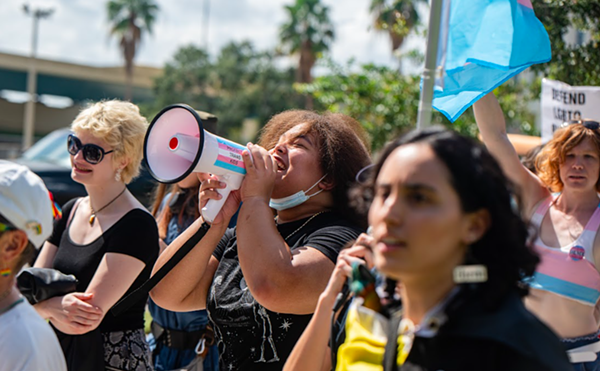Scott Earle, inmate #L00951 at the Sumter Correctional Institution in Bushnell, Fla., says he was "a mess" when he was first put behind bars in 1997. "I had pills in the top pocket of my shirt," Earle says. "The booking officer said: ‘What are you, crazy? Isn't that the thing you're in for?'"
Earle had long been addicted to Vicodin and other pain medications containing oxycodone; he was first introduced to them at the age of 16 when he broke his arm while playing hockey. One night in September 1995, at Gary's Sports Bar in Pompano Beach, a beautiful woman struck up a conversation with Earle. The bottle of Vicodin in his pocket somehow came up, and the woman, Lisa, asked if she could have a few pills for her aching back. Earle obliged, which marked the beginning of a three-month relationship - sometimes intimate - with Lisa. She frequently requested that Earle supply her with pain medications, eventually outpacing what he could supply from his personal stash, so he found a supplier through his brother's girlfriend. Before long Earle was a middleman, passing cash one way and pills the other way. He compensated himself by taking some pills off the top. She never complained when he came up short on pills, so the more she ordered, the more Earle took. In December, the hammer finally came down: Lisa met Earle in his car, where he placed a paper bag containing 365 Percosets (she had ordered 400) in her lap. That's when the squad cars moved in.
"When they arrested me that night, I was lit," he says. "I had probably about 15 [pills] in me."
Earle was slapped with eight different charges under Florida's drug-trafficking statute, which states "any person who knowingly sells, purchases, manufactures, delivers or brings into this state, or who is knowingly in actual or constructive possession of … any mixture containing" oxycodone and weighing at least 28 grams (roughly the weight of half a Snickers candy bar) must be sentenced to a minimum of 25 years in prison.
At that time, it was the same minimum sentence reserved for a conviction of first-degree murder. That fact was not lost on his sentencing judge, 17th Judicial Circuit Court Judge Mark Speiser: "So in your opinion the man deserves the same punishment of someone who goes and murders someone in cold blood and gets sentenced to a 25 [year] minimum mandatory sentence?" Speiser asked prosecuting attorney John Gallagher at Earle's hearing in 1998.
"We don't write the laws," Gallagher replied. "The laws are on the book."
Speiser had no choice but to sentence Earle, who had no prior convictions, to 25 years behind bars. "Even the officers I talked to in prison along the way would say: ‘Boy. You got screwed,'" Earle says.
Earle also says he isn't the only one. Since the "tough on crime" era of corrections began more than 30 years ago, mandatory minimum prison sentences have become increasingly popular across the nation; in Florida, they exist for crimes ranging from identity theft and driving under the influence to illegally harvesting blue crabs and selling horse meat without a proper label. The mandatory minimums with the biggest impact on the state's prisons, though, have been those couched within Florida's drug-trafficking statute. For example, only 14 grams of oxycodone suffices for a minimum 15-year sentence, which is what Earle's bunkmate, David Deane, is serving for 20 Vicodin pills.
Inmates like Earle and Deane, consequently, have helped contribute to the explosive population growth in Florida's prisons: Since the state's drug-trafficking statute was enacted in 1979, the Florida per-capita incarceration rate has more than doubled. Since fiscal year 1994-1995 (the earliest year for which the Florida Department of Corrections can provide data), a total of 18,279 people have been admitted to prison on mandatory minimum sentences for drug offenses. The number sentenced per year has increased markedly as well. Between July 1, 1994, and June 30, 1995, 560 drug offenders began serving mandatory minimum sentences of some kind; by last fiscal year, that number had nearly quadrupled to 2,041. Corrections officials can't provide any solid data on how many people in state prison now are serving mandatory minimum sentences, though they say that as of June 30, 2010, 19,414 inmates - 19 percent of a total 102,232 prisoners - were serving time on "drug offenses." Regardless of whether those offenders are serving mandatory time or not, they've likely come in contact with the laws - after all, prosecutors have found the prospect of a mandatory minimum prison term to be an excellent tool in securing plea deals.
Despite the fact that some judges complain that mandatory minimums reduce their ability to use discretion in sentencing, making them drones serving the system, the state's mandatory minimums for drug crimes remained unchallenged for more than 30 years. Recently though, the state's budget has cast a light on Florida's prison spending, which has gone up along with its jail population. At the beginning of this year's legislative session, lawmakers on both sides of the aisle submitted bills that would strike mandatory minimums from the state's drug-trafficking statute - one in the House and one in the Senate. It was the first time in decades that it looked like there was a chance that mandatory minimums could face a serious challenge in the legislature. On March 22, though, the House bill was stripped of language that would have abolished them; the Senate bill, still in committee as this issue goes to press, may face a similar fate by the time it gets to the floor of the legislature.
HB 917 is a forward-thinking criminal-justice bill: It would create a reentry program for nonviolent offenders that would involve substance-abuse treatment, adult basic education courses, vocational training and other rehabilitation programs, and the bill could cut a prisoner's sentence by up to half. In its original form, the bill also called for the elimination of all mandatory minimum sentencing guidelines for non-violent drug offenses. The bill's sponsor, State Rep. Ari Porth, D-Coral Springs, says that the state could spend far less money on corrections - and furthermore, get far better results - if non-violent drug offenders were rehabilitated, rather than incarcerated. Despite having evidence to support his theory, it's a proposal he didn't dare present until this year.
"I think the fact that our state has a multi-billion dollar budget deficit is making this legislation, [which] wouldn't have been able to be talked about several years ago, something that's actually viable," he says. The argument was shot down by Florida's Speaker of the House, Dean Cannon, who appoints the committees that decide whether a bill gets to live or die. (In a March 21 budget allocation memo to House committee leaders, Cannon wrote: "The House budget will not revise adult sentencing policies, change inmate release schedules, or take any action that jeopardizes the long-term safety of the public to save money in the current fiscal year.") But the fact that the issue has been raised at all suggests a shifting mentality in Tallahassee regarding crime and punishment - even if it is one that's being driven primarily by fiscal necessity, rather than concern about criminal-justice policy.
With a budget of $2.4 billion, the Department of Corrections is the state's largest agency; consequently, it has earned a prominent place on Gov. Scott's chopping block (the governor's office did not reply to requests for comment on this story). Shortly after he was elected, Scott appointed a "Law and Order Transition Team" that recommended an overhaul of the state's mandatory minimum laws and in his budget proposal, he suggested cutting nearly 1,700 jobs from the Department of Corrections, which he says would save the state more than $80 million.

Florida's trend toward incarceration began in 1979, with the passage of the state's drug-trafficking statute, which delineates punishments for various drug crimes. For each different drug, or family of drugs, the law created a three-tiered system of mandatory minimum sentencing rules. Possession of a lesser amount of a drug (and what is considered a small amount differs for different drug classes) would yield sentences of three years; possession of a moderate amount would yield either a five- or 10-year sentence and a larger quantity would yield either a 15- or 25-year sentence. Fines are also mandatory - one conviction, depending on the drug and the amount of it, could mean anywhere from $25,000 to $500,000 in fines for the perpetrator, as well. (Because Scott Earle was convicted on multiple counts of trafficking, he owes the state $2.15 million.)
The amount of prison time tied to a particular drug, and the amount possessed, varies widely: Being caught with 1,999 pounds of marijuana in Florida results in three years in prison and a $25,000 fine; being caught with 28 grams of heroin is enough for 25 years behind bars and a half-million dollar fine.
When the original statute - which focused only on marijuana, cocaine and opium - was put to vote in the state Senate on April 5, 1979, it was approved 38-2. It was passed to the House, and the following day, all 116 representatives present voted for the bill. Mandatory minimum sentences were added for PCP and Quaaludes in 1980; methamphetamine in 1989; hydrocodone and oxycodone in 1995; roofies in 1997; GHB, MDMA and ecstasy in 2000; and LSD in 2001.
"We had a more hardened attitude about drugs," says Dick Batchelor, an Orlando businessman who served in the Florida House of Representatives between 1974 and 1982, and voted in favor of the law. "Hard drugs equals crime equals mandatory sentencing. That was kind of the law du jour back then."
Batchelor and his fellow legislators were, in some ways, just reacting to their environment. The drug trade was burgeoning in the late 1970s, and Miami was turning into a business hub for drug cartels. Only three months after the drug trafficking law was passed, for instance, a Colombian drug trafficker and his bodyguard were gunned down during the day in a Miami liquor store by two men wielding submachine guns. Known as the Dadeland Mall shooting, the event served as justification for the newly minted penalties. "If you mentioned the word ‘drugs' back then, you conjured all kinds of images dealing with crime," Batchelor says.
In addition, the "medical model" of corrections, which stressed "individualized treatment programs," including education, counseling and vocational training, had been employed at the federal level since the 1930s but had shown few results. Mandatory minimum sentences, lawmakers hoped, would not only address rampant crime, but also deter it. Proponents also argued that sentence uniformity would prevent judges who were considered "soft" on drug dealers and other criminals from being able to issue light sentences for crimes perceived as serious by lawmakers.
Dr. Roberto "Hugh" Potter, director of research at the University of Central Florida's Department of Criminal Justice, remembers the transition from a liberal to a conservative era of corrections clearly. In 1980, he was finishing up his doctorate in sociology at the University of Florida. One day, he was taken aside by Paul Cressey, an advisor on his academic study on juvenile diversion programs who also worked for the federal Bureau of Prisons.
"Hugh, I know you believe in rehabilitation," Potter recalls Cressey saying. "But I want you to drop the word. For the next 20 years, if you're to use the word ‘rehabilitation,' nobody will take you seriously."
Cressey's advice was more like a prophecy. As of 2009, Florida had the seventh highest per-capita incarceration rate in the nation - 559 inmates per 100,000 residents, according to the Kaiser Family Foundation, a nonprofit health care policy research organization. (The per-capita incarceration rate in 1980, by contrast, was 200 inmates per 100,000 residents.). Opponents of mandatory minimums say the laws have been a significant reason for the increase.
When Scott Earle is asked to make a rough estimate of how many others at the Sumter Correctional Institution are serving mandatory drug time, he says: "Everyone to the left of me and to the right of me."
A challenge to mandatory minimum sentences may be new to the Florida legislature, but it's a familiar battle for Families Against Mandatory Minimums (FAMM), a nonprofit based in Washington, D.C., which has been campaigning against mandatory minimum sentencing since 1991, largely focusing on drug-sentencing laws. The organization was founded by Julie Stewart, formerly a director of public affairs for the Cato Institute. Stewart's brother was arrested in 1990 for growing marijuana and was later sentenced to five years in federal prison. What struck Stewart was how the judge openly lamented having to impose such a sentence on her brother.
"It wasn't just my brother's conviction, it was the judge's inability to give him the sentence he thought was appropriate that really launched me on this crusade to ensure, or restore or protect individualized sentencing," Stewart says.

Therefore, FAMM, which boasts a membership of at least 20,000 inmates and their family members, opposes all mandatory minimum sentences as a matter of principle. "We want individuals to be judged on what they've done, in that particular case, and have all of the factors about their life be brought to bear on the final sentence," Stewart says.
Since its inception, FAMM has been instrumental in changing drug sentencing at both the federal and state levels. In 1994, it pressed successfully for the creation of a "safety valve" in the federal drug-sentencing statutes, which allowed drug offenders out of mandatory minimum sentences if they met five specific criteria. In 1998, thanks to pressure from FAMM, Michigan revoked its "650-lifer" law, which had mandated life in prison without parole for anyone found with 650 grams or more of cocaine or heroin. In 2007, FAMM successfully pressed for the "crack minus two" amendment to federal crack cocaine sentencing law, which made 3,804 prisoners eligible for early release the following year.
Last October, FAMM launched a campaign in Florida, which is only the second state to receive full-time attention (the other is Massachusetts) from the organization, which has an annual budget of $1,407,062 and spends $240,000 per year on lobbying. FAMM communications director Monica Pratt Raffanel says that Florida and Massachusetts were chosen because the mandatory minimum sentences in those states are "particularly egregious" and "ripe for reform."
FAMM Florida's director, Greg Newburn, says he visited Tallahassee "at least" eight times in March, mostly lobbying for HB 917 and SB 1334. (Newburn is based in Gainesville; FAMM also employs a part-time lobbyist who lives in Tallahassee.) Since FAMM's Florida campaign began, Newburn has gotten plenty of media attention: The Ledger, The Gainesville Sun, and Broward-Palm Beach New Times, among other outlets, have quoted him. "If you look at a mandatory minimum sentence, you will uncover some injustice, somewhere, where someone who didn't deserve to be punished under that law has been," he says.
Mention of FAMM to those within the criminal justice system often spurs a larger discussion about mandatory minimums. Judges and public defenders are more apt to dislike them, while prosecutors are warmer to them.
"[W]e generally find that use of mandatory minimums can be helpful tools when presenting and prosecuting cases," writes Ron Ishoy of the Broward County State Attorney's office in an email to the Weekly. "Prosecutors have the authority to waive a mandatory trafficking sentence and they often do, especially with drug users and small-time traffickers."
(Except Scott Earle, who was prosecuted by Ishoy's office, could hardly be considered a big-time trafficker. "Because of the definitions in the bills, we're capturing drug addicts, [but] we're not really capturing those that are traffickers," says State Sen. Ellyn Bogdanoff.)
Judge Speiser, however, takes issue with the fact that only a prosecutor can choose to forego the mandatory minimum charge. "Why should all that power be bestowed with the prosecutor?" Speiser says. "Why not extend it to the judge?"
Victor Crist, a former State Senator and the architect of Florida's 10-20-LIFE gun crime law that was passed in 1999 - which imposes a minimum sentence of 10 years for carrying a gun while committing a felony and 20 years to life for firing a gun while committing a felony - is still a believer in mandatory minimum sentences, but he also acknowledges their drawbacks. "It does take away judges' discretion, and that's unfortunate," he says. "When there's an epidemic of certain criminal activity, unfortunately, it becomes necessary to do a minimum mandatory."
Indeed, the crime rate has fallen significantly since the drug-trafficking statute was passed in 1979: That year, the state averaged 7,255 crimes per 100,000 residents; three decades later, the rate has declined to 4,398 crimes per 100,000 residents.
Still, Crist indicates that mandatory minimum sentences should not be set in stone. "We should always be revisiting our minimum mandatories to determine if they're still necessary or not," he says. "Society evolves. And so should our laws."
Regardless of where one stands on whether mandatory minimums are worthwhile, one thing is indisputable: It costs more money to keep somebody in prison for a longer period of time.
According to the Department of Corrections, the state of Florida spends an average of $19,469 per prisoner, per year, which means that roughly $2 billion was spent on prisoners between July 1, 2009, and June 30 of last year.
A new nationwide conservative movement called "Right on Crime" argues that long prison sentences are not worth the financial nor the social cost, and advocates instead for the elimination of some mandatory minimums for non-violent crimes, along with a host of other reforms to the criminal justice system both at the national and the state level. The movement, which launched its Florida campaign on March 22, includes some prominent backers, such as Newt Gingrich, former speaker of the U.S. House of Representatives, William Bennett, formerly George H.W. Bush's "drug czar," and Grover Norquist, president of Americans for Tax Reform.
A local supporter of Right on Crime is Florida TaxWatch, a nonprofit watchdog group which proposes cost-cutting measures to the legislature in its annual Government Cost Savings Task Force report. This year's report suggested no less than 23 changes to the state's criminal and juvenile justice system, including the creation of post-adjudicatory and post-incarceration drug courts.
"The cost of incarceration is significantly greater than even a modest treatment," says Dominic Calabro, president of Florida TaxWatch. The state of Florida estimates that rehabilitation programs administered through a circuit drug court cost between $950 to $2,500 per individual, per year - which, at most, would be about 13 percent the cost of incarcerating that same individual. That means that if only half of the state's 19,723 drug offenders were successfully diverted towards said programs, the state could save more than $167 million.
But to some conservatives, cost savings are but a minor benefit of abandoning the state's dependence on incarceration. The real positive impact of rehabilitation programs, according to Rev. Allison DeFoor, who served as both judge and sheriff of Monroe County, is a reduction in the recidivism rate. "Whether they do 10 years, 20 years or 50 years, if you don't address [their] issues, they're going to come back," DeFoor says.
A report released by a Florida Supreme Court task force in July 2004 indicates that drug courts greatly reduce recidivism for drug crimes. While the statewide average recidivism rate has hovered around 33 percent for the past decade, the report found that drug courts in Broward County, Escambia County and Palm Beach County boasted graduate recidivism rates of 19 percent, 12 percent and 6 percent, respectively. "The bottom line is that studies continue to show that drug court graduates have significantly reduced recidivism rates, thereby enhancing public safety," the report states.
DeFoor is confident that Gov. Scott will take heed of conservatives' advice to expand rehabilitation programs and faith-based facilities - in fact, when the Weekly spoke with DeFoor on March 15, he had just left a budget briefing at Scott's office.
Not that the governor needed a reminder: On Dec. 15, his Law and Order Transition team published a report that espoused ideologies that aligned surprisingly well with those of FAMM and Right on Crime. "It is clear that the current criminal laws do not allow for the judiciary to use prudent judgment in sentencing recommendations that could and would reduce the ballooning population of corrections," the report states. "Legislative actions are needed to repeal/preempt existing statutory requirements and policy based bans that do not allow a consideration of rehabilitation."
"We need to have data-driven criminal justice, and everybody from the left to the right are trying to get there now," concludes DeFoor. "And this governor is very much data-driven."
Veterans of the corrections system are welcoming the conservatives' shift in perspective. "I do think that we've gone from being hard on crime to, hopefully, being smart on crime," says Vicki Lukis, vice chair of the Department of Corrections' Re-Entry Advisory Council and formerly Chair of Governor Jeb Bush's Ex-Offender Task Force. "At some point, you have to ask yourself, is a substance abuser best suited to be in a prison for 15 years?"
If HB 917 passes in its current form, then Scott Earle would be an ideal candidate for the state's new reentry program: He's already served more than half of his sentence, has never been convicted of a violent crime and he isn't a registered sexual offender.
But there's one crucial thing that Earle lacks: an addiction. The proposed legislation states that in order to qualify for the program, "a nonviolent offender must have … been identified as having a need for substance abuse treatment." Like many other addicts booked into Florida jails, Earle got over his addiction cold turkey, by virtue of having no other options.
But what about SB 1334? Even if that sails through the legislature untouched, which seems unlikely, it still would not provide for the early release of anyone already serving a mandatory minimum sentence for a drug offense, unless that person met the qualifications of the new reentry program.
"It's hard to do the retroactive," says Sen. Bogdanoff. "You'd have to go back and revisit all the different facts and circumstances of a case. It could be a very arduous process. But that doesn't mean that the governor couldn't commute somebody's sentence."
FAMM's Stewart says that retroactivity is often left out of, or struck from drug sentencing reform bills, as a bargaining chip. She recalls retroactivity being stripped out of the 1994 federal safety valve bill "in the 11th hour" of negotiations. "The safety valve, while it was an enormous victory, it was also one of the saddest days of my life," she says.
Retroactivity, the sentencing reform most difficult to convince legislators to embrace, and hence the one requiring the most time to achieve, is also, ironically, the most time-sensitive. For example, after several fruitless years, FAMM stopped pressing for retroactivity in the federal safety valve statute because most of those affected had already done their time.
"It drives me nuts, frankly, that there's ever a question of retroactivity," she says. "It is equity. If the legislative body decides that this law is unjust, from here forward, it was on the backs of all those people who are prison right now that the arguments were made … and now we're not going to let them benefit from the change?"
A legislative staffer pointed out in an email that Florida's Constitution states that "repeal or amendment of a criminal statute shall not affect prosecution or punishment for any crime previously committed." The staffer, who did not want to be identified, added that making the change retroactive would therefore require a constitutional amendment, which would be far more difficult to accomplish.
Barring a constitutional amendment, then, the 140 people who entered prison with 25-year minimum drug sentences last year will likely remain there for the next two decades, since another mandatory minimum statute, called the Truth-in-Sentencing Act, mandates that prisoners serve no less than 85 percent of their sentences.
Surely, at least one organization will be hard at work for the foreseeable future.
"I feel it's our responsibility to help humanize and personalize the policies that are otherwise so abstract and complex," Julie Stewart says. "If you read sentencing law, it's boring - but when you see it applied to real people … it becomes flesh and blood."



















